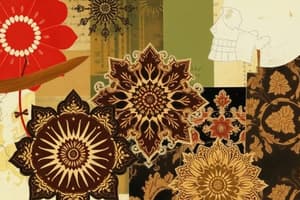Podcast
Questions and Answers
What is the primary purpose of Tortor Pangurason?
What is the primary purpose of Tortor Pangurason?
- To pay homage to elders
- To purify the environment before a major event (correct)
- To communicate with spirits
- To celebrate festivals
What is the significance of hand movements in Tortor?
What is the significance of hand movements in Tortor?
- They are deliberate and symbolic (correct)
- They are random and spontaneous
- They are not used in Tortor at all
- They are only used in Tortor Somba
Which of the following is NOT a traditional Batak musical instrument used in Tortor?
Which of the following is NOT a traditional Batak musical instrument used in Tortor?
- Gondang
- Hasapi
- Ogung
- Guitar (correct)
What is the purpose of Tortor Tunggal Panaluan?
What is the purpose of Tortor Tunggal Panaluan?
What is the traditional attire worn by dancers during Tortor?
What is the traditional attire worn by dancers during Tortor?
What is the primary function of Tortor in Batak cultural and ceremonial life?
What is the primary function of Tortor in Batak cultural and ceremonial life?
Flashcards are hidden until you start studying
Study Notes
Tortor Dance
- Tortor is a traditional dance of the Batak people, including the Simalungun subgroup, and plays a significant role in their cultural and ceremonial life.
Significance of Tortor
- Tortor is more than just a dance; it's a medium for storytelling, communication, and religious expression.
- It's performed during various ceremonies, including weddings, funerals, and festivals, serving both ritualistic and celebratory purposes.
Types of Tortor
- Tortor Pangurason: a cleansing dance performed to purify the environment before a major event.
- Tortor Somba: a dance of homage and respect, often directed toward elders, ancestors, or important guests.
- Tortor Tunggal Panaluan: a dance performed by a single dancer, usually a shaman or priest, often associated with rituals and spiritual communication.
Tortor Movements
- The movements in Tortor are deliberate and symbolic, often mimicking natural elements, daily activities, or spiritual beliefs.
- Common gestures include: Hand Movements, footwork, body posture.
Music and Instruments
- Tortor is accompanied by traditional Batak musical instruments, which create a rhythmic and melodic backdrop for the dance.
- Key instruments include: Gondang, Taganing, Hasapi, Ogung.
Attire
- Dancers typically wear traditional Batak clothing, which includes: Ulos, Headdresses, Jewelry.
Studying That Suits You
Use AI to generate personalized quizzes and flashcards to suit your learning preferences.





